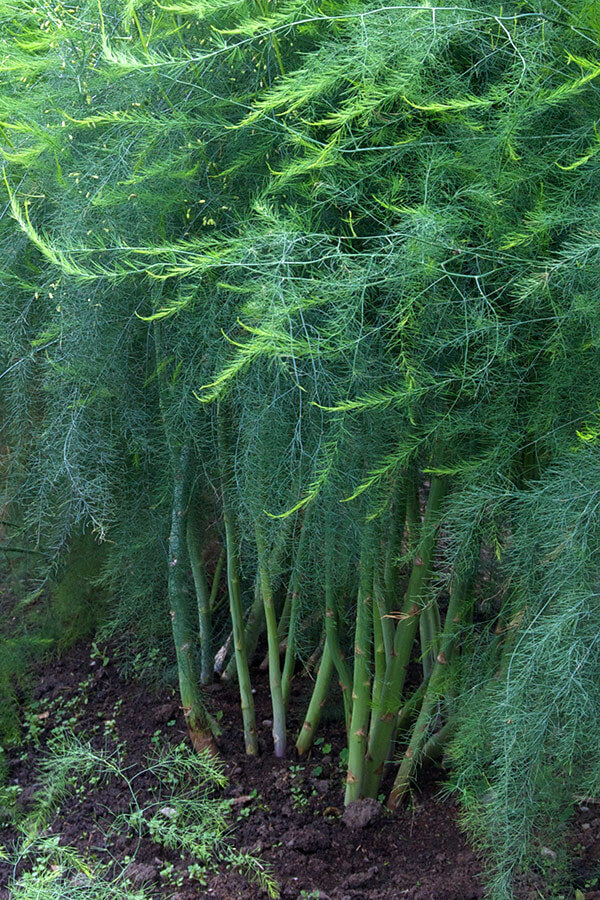Growing asparagus is an investment in your culinary future. Unlike most vegetables, asparagus plants are perennial, which means the same plants grow in your garden year after year. The spears that we enjoy as a vegetable are the new shoots that emerge in spring. The most important part of growing asparagus is to realize that it will take a couple of seasons before you taste the first bite of homegrown asparagus. Plants need to be allowed to mature before you can harvest. They will remain in the same place in your garden for many years—15, 20, sometimes 30. In fact, a productive asparagus bed is a good reason to renovate your house, rather than move!
Asparagus can be grown in most parts of the country but does especially well in cooler regions with longer, colder winters. These periods of dormancy allow asparagus stalks to grow more robustly in the spring than they do in warmer regions with milder winters.
How much your family enjoys asparagus determines how many plants you will need. A good start is 10 plants for each person. If it is a family favorite or you plan to freeze some for later, you will need more. Planting more than just asparagus? Read How to Lay Out a Vegetable Garden for tips on where to put everything.
Quick Guide to Growing Asparagus
- Plant asparagus in spring or fall in a sunny spot with nutrient-rich, well-drained soil.
- Asparagus takes a few seasons to mature but will reap a harvest for 15 to 30 years, so choose a planting location that will go undisturbed for a long time.
- For spring planting, prepare your garden bed in the fall by improving the soil with compost or other rich organic matter, then cover the bed with mulch for the winter.
- In spring, dig 6- to 8-inch deep rows and plant asparagus 12 to 18 inches apart.
- As asparagus grows taller, backfill the rows with soil until it is eventually level with the garden bed.
- Once your rows are level with the soil line, lay down a layer of mulch to retain soil moisture and prevent weeds.
- During the growing season, feed regularly with a continuous-release plant food.
- Wait until your second or third season to harvest. You can pick mature asparagus once they reach 8 inches tall.
Soil, Planting, and Care
The key to growing asparagus is to have healthy, vigorous plants that produce a lot of spears. Choose a sunny, well-drained site on the edge of your garden where it will not be disturbed by the activity of planting and re-planting other areas.
Planting asparagus is like preparing for a trip. Careful preparation makes the journey easier. It is the same with asparagus. Before you buy the plants, you need a prepared bed. How well you prepare the bed determines the vigor of your asparagus patch for years to come. (See more on that below.) When you do buy plants, make sure they're Bonnie Plants® asparagus. Strong and vigorous, these young plants will give your asparagus patch an excellent start—and put you way ahead of where you would be if you were to plant seeds.
In autumn, prepare the soil by mixing in several inches of organic matter (think compost or aged leaves) or compost-enriched Miracle-Gro® Performance Organics® All Purpose In-Ground Soil with the native soil in each row. This will provide all the nutrition your new asparagus plants need to start growing. Mulch for the winter, or grow a cool-season cover crop that can be turned under before planting in spring.
In spring, after danger of frost has passed, dig a depression 6 to 8 inches deep running the length of the row, mounding the improved soil on each side for later use. Set seedlings into the lowest part of the depression, planting about 2 inches deeper than they were originally growing. Space plants 12 to 18 inches apart. (Asparagus can also be planted in the fall. For more on that, check out our How to Plant a Fall Garden article.)
In addition to great soil, asparagus needs a steady supply of plant food to grow its best. Feed your plants with Miracle-Gro® Performance Organics® Edibles Plant Nutrition Granules regularly during the growing season, following the directions on the label. In addition to feeding your plants, this organic fertilizer feeds the beneficial microbes in the soil that help those plants take up more nutrition.
As plants grow taller, rake a little of the soil on the edge of the row into the depression where plants are growing. Soon the bed will be level. Mulch to prevent weeds.
Then all you need to do is be patient. The idea is to wait at least 2 seasons and probably 3 before harvesting. It may be hard to resist tasting the first spears to emerge, but go easy on the plants until they mature. You'll be rewarded in the long run!
Troubleshooting
Bent spears are caused by insects feeding or damage from cutting adjacent stalks. The damaged stalk grows normally on the side away from the wound, causing the spear to bend.
A well-drained bed will have minimal disease problems. Black and red asparagus beetles can be a challenge, damaging the foliage and weakening the roots. Usually, you can control them with hand picking. Just drop them into a bucket of soapy water.
Harvest and Storage
Once asparagus plants are strong enough to be harvested, cut all new shoots in spring when they are about 8 inches tall, snapping them off at the soil line. Many seasoned gardeners use a knife to cut below the soil line, but it is important to avoid cutting into emerging spears nearby. Also, the knife can spread any disease from one plant to the next.
Remember, if the spear has begun opening and developing foliage, it will be too tough to eat. To avoid this happening, plan to harvest at least every other day. Go ahead and pick all the spears each time you harvest. Discard those that have grown too large.
The duration of your harvest will depend on the vigor of your plants. If your plants are young, the fresh asparagus season may last a couple of weeks. However, established plants can produce much longer, as much as 8 weeks. The old rule of thumb is to harvest until the diameter of the spear decreases to the size of a pencil. Then it is time to stop and let them grow, gaining strength for next spring.
Cook cut spears immediately or refrigerate in plastic to raise the humidity and prevent tough fibers from forming at the base of the spear. These fibers form as a result of the injury of cutting. That's why spears from the grocery store or from the refrigerator should always be trimmed to remove any tough tissue before cooking.
Fresh asparagus spears can be stored a week or more. If you want to put some aside to enjoy in the months to come, blanch them in boiling water for 3 to 5 minutes, douse in cold water, wrap, and freeze.
Cut back the 4 to 6-foot tall foliage, or the ferns as they are called, after frost has turned them brown. This is a good time to control weeds because the asparagus are dormant. Keeping the bed weed-free is important to avoid competition with your asparagus plants. Because the soil is so rich, invaders can take hold quickly.









 Herbs
Herbs
 Vegetables
Vegetables
 Fruit
Fruit
 Flowers
Flowers
 Succulents
Succulents


